Lignocellulosic Biomass for the Fabrication of Triboelectric Nano-Generators (TENGs)—A Review
Abstract
:1. Introduction
2. Lignocellulosic Biomass: Components and Composition
3. Treatments Used to Isolate the Components of Lignocellulose Biomass
3.1. Extraction of Cellulose and Derivatives
3.2. Extraction of Lignin
3.3. Extraction of Hemicellulose
4. TENGs Based on Lignocellulose and Its Derivatives
4.1. Refined Lignocellulose-Based TENGs
4.1.1. Cellulose Based-TENGs
4.1.2. Lignin-Based TENGs
4.1.3. TENGs Based on Other Lignocellulosic Components
4.2. TENGs Based on Non-Refined Lignocellulose
5. Applications of Lignocellulose-Based TENGs
6. Conclusions
Author Contributions
Funding
Institutional Review Board Statement
Informed Consent Statement
Data Availability Statement
Conflicts of Interest
References
- Annamalai, P.K.; Nanjundan, A.K.; Dubal, D.P.; Baek, J.B. An Overview of Cellulose-Based Nanogenerators. Adv. Mater. Technol. 2021, 6, 2001164. [Google Scholar] [CrossRef]
- Cai, J.; He, Y.; Yu, X.; Banks, S.W.; Yang, Y.; Zhang, X.; Yu, Y.; Liu, R.; Bridgwater, A.V. Review of Physicochemical Properties and Analytical Characterization of Lignocellulosic Biomass. Renew. Sustain. Energy Rev. 2017, 76, 309–322. [Google Scholar] [CrossRef]
- Chen, H. Lignocellulose Biorefinery Engineering: Principles and Applications. In Lignocellulose Biorefinery Engineering: Principles and Applications; Elsevier: Amsterdam, The Netherlands, 2015; pp. 1–261. [Google Scholar] [CrossRef]
- Hassan, S.S.; Williams, G.A.; Jaiswal, A.K. Emerging Technologies for the Pretreatment of Lignocellulosic Biomass. Bioresour. Technol. 2018, 262, 310–318. [Google Scholar] [CrossRef]
- Smith, M.D. An Abbreviated Historical and Structural Introduction to Lignocellulose. ACS Symp. Ser. 2019, 1338, 1–15. [Google Scholar] [CrossRef]
- Lee, H.V.; Hamid, S.B.A.; Zain, S.K. Conversion of Lignocellulosic Biomass to Nanocellulose: Structure and Chemical Process. Sci. World J. 2014, 2014, 631013. [Google Scholar] [CrossRef] [PubMed]
- Saini, J.K.; Saini, R.; Tewari, L. Lignocellulosic agriculture wastes as biomass feedstocks for second-generation bioethanol production: Concepts and recent developments. 3 Biotech 2015, 5, 337–353. [Google Scholar] [CrossRef]
- Haldar, D.; Purkait, M.K. Micro and Nanocrystalline Cellulose Derivatives of Lignocellulosic Biomass: A Review on Synthesis, Applications and Advancements. Carbohydr. Polym. 2020, 250, 116937. [Google Scholar] [CrossRef]
- Fan, F.-R.; Tian, Z.-Q.; Wang, Z.L. Flexible triboelectric generator. Nano Energy 2012, 1, 328–334. [Google Scholar] [CrossRef]
- Alam, S.N.; Ghosh, A.; Shrivastava, P.; Shukla, U.; Garg, K.; Edara, A.C.; Sahoo, N. An introduction to triboelectric nanogenerators. Nano-Struct. Nano-Objects 2023, 34, 100980. [Google Scholar] [CrossRef]
- Torres, F.G.; Gonzales, K.N.; Troncoso, O.P.; Corman-Hijar, J.I.; Cornejo, G. A Review on the Development of Biopolymer Nanocomposite-Based Triboelectric Nanogenerators (Bio-TENGs). ACS Appl. Electron. Mater. 2023, 5, 3546–3559. [Google Scholar] [CrossRef]
- Mankar, A.R.; Pandey, A.; Modak, A.; Pant, K.K. Pretreatment of Lignocellulosic Biomass: A Review on Recent Advances. Bioresour. Technol. 2021, 334, 125235. [Google Scholar] [CrossRef]
- Shi, S.C.; Chen, C.; Zhu, J.L.; Li, Y.; Meng, X.; Huang, H.D.; Li, Z.M. Environmentally Friendly Regenerated Cellulose Films with Improved Dielectric Properties via Manipulating the Hydrogen Bonding Network. Appl. Phys. Lett. 2021, 119, 40820. [Google Scholar] [CrossRef]
- Luo, Q.; Shen, H.; Zhou, G.; Xu, X. A Mini-Review on the Dielectric Properties of Cellulose and Nanocellulose-Based Materials as Electronic Components. Carbohydr. Polym. 2023, 303, 120449. [Google Scholar] [CrossRef] [PubMed]
- Vanholme, R.; Demedts, B.; Morreel, K.; Ralph, J.; Boerjan, W. Lignin Biosynthesis and Structure. Plant Physiol. 2010, 153, 895–905. [Google Scholar] [CrossRef] [PubMed]
- Ralph, J.; Lapierre, C.; Boerjan, W. Lignin Structure and Its Engineering. Curr. Opin. Biotechnol. 2019, 56, 240–249. [Google Scholar] [CrossRef]
- Ragauskas, A.J.; Beckham, G.T.; Biddy, M.J.; Chandra, R.; Chen, F.; Davis, M.F.; Davison, B.H.; Dixon, R.A.; Gilna, P.; Keller, M.; et al. Lignin Valorization: Improving Lignin Processing in the Biorefinery. Science 2014, 344, 1246843. [Google Scholar] [CrossRef] [PubMed]
- Watkins, D.; Nuruddin, M.; Hosur, M.; Tcherbi-Narteh, A.; Jeelani, S. Extraction and Characterization of Lignin from Different Biomass Resources. J. Mater. Res. Technol. 2015, 4, 26–32. [Google Scholar] [CrossRef]
- Tan, Y.T.; Chua, A.S.M.; Ngoh, G.C. Evaluation on the Properties of Deep Eutectic Solvent-Extracted Lignin for Potential Aromatic Bio-Products Conversion. Ind. Crops Prod. 2020, 154, 112729. [Google Scholar] [CrossRef]
- Hong, S.; Sun, X.; Lian, H.; Pojman, J.A.; Mota-Morales, J.D. Zinc Chloride/Acetamide Deep Eutectic Solvent-Mediated Fractionation of Lignin Produces High- and Low-Molecular-Weight Fillers for Phenol-Formaldehyde Resins. J. Appl. Polym. Sci. 2020, 137, 48385. [Google Scholar] [CrossRef]
- Wang, W.; Lee, D.J. Lignocellulosic Biomass Pretreatment by Deep Eutectic Solvents on Lignin Extraction and Saccharification Enhancement: A Review. Bioresour. Technol. 2021, 339, 125587. [Google Scholar] [CrossRef]
- Stewart, D. Lignin as a Base Material for Materials Applications: Chemistry, Application and Economics. Ind. Crops Prod. 2008, 27, 202–207. [Google Scholar] [CrossRef]
- Wang, M.; Leitch, M.; (Charles) Xu, C. Synthesis of Phenol–Formaldehyde Resol Resins Using Organosolv Pine Lignins. Eur. Polym. J. 2009, 45, 3380–3388. [Google Scholar] [CrossRef]
- Huang, C.; Peng, Z.; Li, J.; Li, X.; Jiang, X.; Dong, Y. Unlocking the Role of Lignin for Preparing the Lignin-Based Wood Adhesive: A Review. Ind. Crops Prod. 2022, 187, 115388. [Google Scholar] [CrossRef]
- Yu, O.; Kim, K.H. Lignin to Materials: A Focused Review on Recent Novel Lignin Applications. Appl. Sci. 2020, 10, 4626. [Google Scholar] [CrossRef]
- Zhang, X.; Yang, W.; Blasiak, W. Modeling Study of Woody Biomass: Interactions of Cellulose, Hemicellulose, and Lignin. Energy Fuels 2011, 25, 4786–4795. [Google Scholar] [CrossRef]
- Lu, Y.; He, Q.; Fan, G.; Cheng, Q.; Song, G. Extraction and Modification of Hemicellulose from Lignocellulosic Biomass: A Review. Green Process. Synth. 2021, 10, 779–804. [Google Scholar] [CrossRef]
- Kumar, A.K.; Sharma, S. Recent Updates on Different Methods of Pretreatment of Lignocellulosic Feedstocks: A Review. Bioresour. Bioprocess. 2017, 4, 7. [Google Scholar] [CrossRef]
- Xie, J.; Hse, C.Y.; De Hoop, C.F.; Hu, T.; Qi, J.; Shupe, T.F. Isolation and Characterization of Cellulose Nanofibers from Bamboo Using Microwave Liquefaction Combined with Chemical Treatment and Ultrasonication. Carbohydr. Polym. 2016, 151, 725–734. [Google Scholar] [CrossRef]
- Dai, L.; He, C.; Wang, Y.; Liu, Y.; Yu, Z.; Zhou, Y.; Fan, L.; Duan, D.; Ruan, R. Comparative Study on Microwave and Conventional Hydrothermal Pretreatment of Bamboo Sawdust: Hydrochar Properties and Its Pyrolysis Behaviors. Energy Convers. Manag. 2017, 146, 1–7. [Google Scholar] [CrossRef]
- Sun, J.X.; Sun, R.C.; Sun, X.F.; Su, Y.Q. Fractional and Physico-Chemical Characterization of Hemicelluloses from Ultrasonic Irradiated Sugarcane Bagasse. Carbohydr. Res. 2004, 339, 291–300. [Google Scholar] [CrossRef]
- Chen, F.; Lu, Z. Liquefaction of Wheat Straw and Preparation of Rigid Polyurethane Foam from the Liquefaction Products. J. Appl. Polym. Sci. 2009, 111, 508–516. [Google Scholar] [CrossRef]
- Juhaida, M.F.; Paridah, M.T.; Mohd Hilmi, M.; Sarani, Z.; Jalaluddin, H.; Mohamad Zaki, A.R. Liquefaction of Kenaf (Hibiscus Cannabinus L.) Core for Wood Laminating Adhesive. Bioresour. Technol. 2010, 101, 1355–1360. [Google Scholar] [CrossRef]
- Kunaver, M.; Jasiukaityte, E.; Čuk, N.; Guthrie, J.T. Liquefaction of Wood, Synthesis and Characterization of Liquefied Wood Polyester Derivatives. J. Appl. Polym. Sci. 2010, 115, 1265–1271. [Google Scholar] [CrossRef]
- Kunaver, M.; Medved, S.; Čuk, N.; Jasiukaityte, E.; Poljanšek, I.; Strnad, T. Application of Liquefied Wood as a New Particle Board Adhesive System. Bioresour. Technol. 2010, 101, 1361–1368. [Google Scholar] [CrossRef]
- Kunaver, M.; Jasiukaityte, E.; Čuk, N. Ultrasonically Assisted Liquefaction of Lignocellulosic Materials. Bioresour. Technol. 2012, 103, 360–366. [Google Scholar] [CrossRef] [PubMed]
- Hamawand, I.; Seneweera, S.; Kumarasinghe, P.; Bundschuh, J. Nanoparticle Technology for Separation of Cellulose, Hemicellulose and Lignin Nanoparticles from Lignocellulose Biomass: A Short Review. Nano-Struct. Nano-Objects 2020, 24, 100601. [Google Scholar] [CrossRef]
- Jiang, F.; Hsieh, Y.L. Chemically and Mechanically Isolated Nanocellulose and Their Self-Assembled Structures. Carbohydr. Polym. 2013, 95, 32–40. [Google Scholar] [CrossRef]
- Chen, Y.W.; Lee, H.V.; Abd Hamid, S.B. Facile Production of Nanostructured Cellulose from Elaeis Guineensis Empty Fruit Bunch via One Pot Oxidative-Hydrolysis Isolation Approach. Carbohydr. Polym. 2017, 157, 1511–1524. [Google Scholar] [CrossRef]
- Islam, M.S.; Kao, N.; Bhattacharya, S.N.; Gupta, R.; Choi, H.J. Potential Aspect of Rice Husk Biomass in Australia for Nanocrystalline Cellulose Production. Chin. J. Chem. Eng. 2018, 26, 465–476. [Google Scholar] [CrossRef]
- Shaheen, T.I.; Emam, H.E. Sono-Chemical Synthesis of Cellulose Nanocrystals from Wood Sawdust Using Acid Hydrolysis. Int. J. Biol. Macromol. 2018, 107, 1599–1606. [Google Scholar] [CrossRef]
- Gupta, G.K.; Shukla, P. Lignocellulosic Biomass for the Synthesis of Nanocellulose and Its Eco-Friendly Advanced Applications. Front. Chem. 2020, 8, 601256. [Google Scholar] [CrossRef]
- Wang, J.; Xu, J.; Zhu, S.; Qiqi, W.; Li, J.; Gao, Y.; Wang, B.; Li, J.; Gao, W.; Zeng, J.; et al. Preparation of nanocellulose in high yield via chemi-mechanical synergy. Carbohydr. Polym. 2021, 251, 117094. [Google Scholar] [CrossRef]
- Kalhor, P.; Ghandi, K. Deep Eutectic Solvents for Pretreatment, Extraction, and Catalysis of Biomass and Food Waste. Molecules 2019, 24, 4012. [Google Scholar] [CrossRef] [PubMed]
- Xu, J.; Li, C.; Dai, L.; Xu, C.; Zhong, Y.; Yu, F.; Si, C. Biomass Fractionation and Lignin Fractionation towards Lignin Valorization. ChemSusChem 2020, 13, 4284–4295. [Google Scholar] [CrossRef] [PubMed]
- Cronin, D.J.; Chen, X.; Moghaddam, L.; Zhang, X. Deep Eutectic Solvent Extraction of High-Purity Lignin from a Corn Stover Hydrolysate. ChemSusChem 2020, 13, 4678–4690. [Google Scholar] [CrossRef]
- Malaeke, H.; Housaindokht, M.R.; Monhemi, H.; Izadyar, M. Deep Eutectic Solvent as an Efficient Molecular Liquid for Lignin Solubilization and Wood Delignification. J. Mol. Liq. 2018, 263, 193–199. [Google Scholar] [CrossRef]
- Troncoso, O.P.; Torres, F.G. Bacterial Cellulose—Graphene Based Nanocomposites. Int. J. Mol. Sci. 2020, 21, 6532. [Google Scholar] [CrossRef] [PubMed]
- Torres, F.G.; Troncoso, O.P.; Gonzales, K.N.; Sari, R.M.; Gea, S. Bacterial Cellulose-Based Biosensors. Med. Devices Sens. 2020, 3, e10102. [Google Scholar] [CrossRef]
- Grande, C.J.; Torres, F.G.; Gomez, C.M.; Carmen Bañó, M. Nanocomposites of Bacterial Cellulose/Hydroxyapatite for Biomedical Applications. Acta Biomater. 2009, 5, 1605–1615. [Google Scholar] [CrossRef]
- Torres, F.G.; Commeaux, S.; Troncoso, O.P. Biocompatibility of Bacterial Cellulose Based Biomaterials. J. Funct. Biomater. 2012, 3, 864–878. [Google Scholar] [CrossRef]
- Rawat, S.; Kumar, A.; Bhaskar, T. Ionic liquids for separation of lignin and transformation into value added chemicals. Curr. Opin. Green Sustain. Chem. 2021, 34, 100582. [Google Scholar] [CrossRef]
- Hong, S.; Shen, X.-J.; Xue, Z.; Sun, Z.; Yuan, T.-Q. Structure–function relationships of deep eutectic solvents for lignin extraction and chemical transformation. Green Chem. 2020, 22, 7219–7232. [Google Scholar] [CrossRef]
- Guiao, K.S.; Tzoganakis, C.; Mekonnen, T.H. Green Mechano-Chemical Processing of Lignocellulosic Biomass for Lignin Recovery. Chemosphere 2022, 293, 133647. [Google Scholar] [CrossRef] [PubMed]
- Loaiza, J.M.; Palma, A.; Díaz, M.J.; Ruiz-Montoya, M.; García, M.T.; García, J.C. Effect of Autohydrolysis on Hemicellulose Extraction and Pyrolytic Hydrogen Production from Eucalyptus Urograndis. Biomass Convers. Biorefin. 2022, 12, 4021–4030. [Google Scholar] [CrossRef]
- Đorđević, T.; Antov, M. The Influence of Hydrothermal Extraction Conditions on Recovery and Properties of Hemicellulose from Wheat Chaff–A Modeling Approach. Biomass Bioenergy 2018, 119, 246–252. [Google Scholar] [CrossRef]
- Tiappi Deumaga, M.F.; Jacquet, N.; Vanderghem, C.; Aguedo, M.; Thomas, H.G.; Gerin, P.; Deleu, M.; Richel, A. Fractionation and Structural Characterization of Hemicellulose from Steam-Exploded Banana Rachis. Waste Biomass Valoriz. 2020, 11, 2183–2192. [Google Scholar] [CrossRef]
- Teng, C.; Yan, Q.; Jiang, Z.; Fan, G.; Shi, B. Production of Xylooligosaccharides from the Steam Explosion Liquor of Corncobs Coupled with Enzymatic Hydrolysis Using a Thermostable Xylanase. Bioresour. Technol. 2010, 101, 7679–7682. [Google Scholar] [CrossRef]
- Wei, L.; Yan, T.; Wu, Y.; Chen, H.; Zhang, B. Optimization of Alkaline Extraction of Hemicellulose from Sweet Sorghum Bagasse and Its Direct Application for the Production of Acidic Xylooligosaccharides by Bacillus Subtilis Strain MR44. PLoS ONE 2018, 13, e0195616. [Google Scholar] [CrossRef]
- Da Silva Braga, R.; Poletto, M. Preparation and Characterization of Hemicellulose Films from Sugarcane Bagasse. Materials 2020, 13, 941. [Google Scholar] [CrossRef]
- Geng, W.; Narron, R.; Jiang, X.; Pawlak, J.J.; Chang, H.M.; Park, S.; Jameel, H.; Venditti, R.A. The Influence of Lignin Content and Structure on Hemicellulose Alkaline Extraction for Non-Wood and Hardwood Lignocellulosic Biomass. Cellulose 2019, 26, 3219–3230. [Google Scholar] [CrossRef]
- Wu, X.; Zhang, T.; Liu, N.; Zhao, Y.; Tian, G.; Wang, Z. Sequential Extraction of Hemicelluloses and Lignin for Wood Fractionation Using Acid Hydrotrope at Mild Conditions. Ind. Crops Prod. 2020, 145, 112086. [Google Scholar] [CrossRef]
- da Silva Mendes, F.R.; Bastos, M.S.R.; Mendes, L.G.; Silva, A.R.A.; Sousa, F.D.; de Oliveira Monteiro-Moreira, A.C.; Cheng, H.N.; Biswas, A.; Moreira, R.A. Preparation and Evaluation of Hemicellulose Films and Their Blends. Food Hydrocoll. 2017, 70, 181–190. [Google Scholar] [CrossRef]
- Yuan, L.; Peng, H.; Hu, L.; Yu, R.; Peng, W.; Ruan, R.; Xia, Q.; Zhang, Y.; Liu, A. Dissolution of Bamboo Hemicellulose in 1-Butyl-3-Methylimidazolium Halide-Based Ionic Liquids. Bioresources 2019, 14, 2097–2112. [Google Scholar] [CrossRef]
- Mohtar, S.S.; Tengku Malim Busu, T.N.Z.; Md Noor, A.M.; Shaari, N.; Mat, H. An Ionic Liquid Treatment and Fractionation of Cellulose, Hemicellulose and Lignin from Oil Palm Empty Fruit Bunch. Carbohydr. Polym. 2017, 166, 291–299. [Google Scholar] [CrossRef] [PubMed]
- Chen, Z.; Reznicek, W.D.; Wan, C. Deep Eutectic Solvent Pretreatment Enabling Full Utilization of Switchgrass. Bioresour. Technol. 2018, 263, 40–48. [Google Scholar] [CrossRef] [PubMed]
- Yu, Q.; Zhang, A.; Wang, W.; Chen, L.; Bai, R.; Zhuang, X.; Wang, Q.; Wang, Z.; Yuan, Z. Deep Eutectic Solvents from Hemicellulose-Derived Acids for the Cellulosic Ethanol Refining of Akebia’ Herbal Residues. Bioresour. Technol. 2018, 247, 705–710. [Google Scholar] [CrossRef] [PubMed]
- Sun, J.; Tu, K.; Büchele, S.; Koch, S.M.; Ding, Y.; Ramakrishna, S.N.; Stucki, S.; Guo, H.; Wu, C.; Keplinger, T.; et al. Functionalized Wood with Tunable Tribopolarity for Efficient Triboelectric Nanogenerators. Matter 2021, 4, 3049–3066. [Google Scholar] [CrossRef]
- Wu, C.; Wang, A.C.; Ding, W.; Guo, H.; Wang, Z.L. Triboelectric Nanogenerator: A Foundation of the Energy for the New Era. Adv. Energy Mater. 2019, 9, 1802906. [Google Scholar] [CrossRef]
- Li, Y.; Zhao, Z.; Liu, L.; Zhou, L.; Liu, D.; Li, S.; Chen, S.; Dai, Y.; Wang, J.; Wang, Z.L. Improved Output Performance of Triboelectric Nanogenerator by Fast Accumulation Process of Surface Charges. Adv. Energy Mater. 2021, 11, 2100050. [Google Scholar] [CrossRef]
- Yao, C.; Hernandez, A.; Yu, Y.; Cai, Z.; Wang, X. Triboelectric Nanogenerators and Power-Boards from Cellulose Nanofibrils and Recycled Materials. Nano Energy 2016, 30, 103–108. [Google Scholar] [CrossRef]
- Saqib, Q.M.; Shaukat, R.A.; Chougale, M.Y.; Khan, M.U.; Kim, J.; Bae, J. Particle Triboelectric Nanogenerator (P-TENG). Nano Energy 2022, 100, 107475. [Google Scholar] [CrossRef]
- Roy, S.; Ko, H.U.; Maji, P.K.; Van Hai, L.; Kim, J. Large Amplification of Triboelectric Property by Allicin to Develop High Performance Cellulosic Triboelectric Nanogenerator. Chem. Eng. J. 2020, 385, 123723. [Google Scholar] [CrossRef]
- Zhang, C.; Zhang, W.; Du, G.; Fu, Q.; Mo, J.; Nie, S. Superhydrophobic Cellulosic Triboelectric Materials for Distributed Energy Harvesting. Chem. Eng. J. 2023, 452, 139259. [Google Scholar] [CrossRef]
- Lin, C.; Zhao, H.; Huang, H.; Ma, X.; Cao, S. PEO/Cellulose Composite Paper Based Triboelectric Nanogenerator and Its Application in Human-Health Detection. Int. J. Biol. Macromol. 2023, 228, 251–260. [Google Scholar] [CrossRef]
- Thakur, D.; Seo, S.; Hyun, J. Three-Dimensional Triboelectric Nanogenerator with Carboxymethylated Cellulose Nanofiber and Perfluoroalkoxy Films. J. Ind. Eng. Chem. 2023, 123, 220–229. [Google Scholar] [CrossRef]
- Chenkhunthod, S.; Yamklang, W.; Kaeochana, W.; Prada, T.; Bunriw, W.; Harnchana, V. Ag–Cellulose Hybrid Filler for Boosting the Power Output of a Triboelectric Nanogenerator. Polymers 2023, 15, 1295. [Google Scholar] [CrossRef]
- Varghese, H.; Hakkeem, H.M.A.; Chauhan, K.; Thouti, E.; Pillai, S.; Chandran, A. A High-Performance Flexible Triboelectric Nanogenerator Based on Cellulose Acetate Nanofibers and Micropatterned PDMS Films as Mechanical Energy Harvester and Self-Powered Vibrational Sensor. Nano Energy 2022, 98, 107339. [Google Scholar] [CrossRef]
- Bao, Y.; Wang, R.; Lu, Y.; Wu, W. Lignin Biopolymer Based Triboelectric Nanogenerators. APL Mater. 2017, 5, 074109. [Google Scholar] [CrossRef]
- An, S.; Sankaran, A.; Yarin, A.L. Natural Biopolymer-Based Triboelectric Nanogenerators via Fast, Facile, Scalable Solution Blowing. ACS Appl. Mater. Interfaces 2018, 10, 37749–37759. [Google Scholar] [CrossRef]
- Sun, D.; Feng, Y.; Sun, S.; Yu, J.; Jia, S.; Dang, C.; Hao, X.; Yang, J.; Ren, W.; Sun, R.; et al. Transparent, Self-Adhesive, Conductive Organohydrogels with Fast Gelation from Lignin-Based Self-Catalytic System for Extreme Environment-Resistant Triboelectric Nanogenerators. Adv. Funct. Mater. 2022, 32, 2201335. [Google Scholar] [CrossRef]
- Funayama, R.; Hayashi, S.; Terakawa, M. Laser-Induced Graphitization of Lignin/PLLA Composite Sheets for Biodegradable Triboelectric Nanogenerators. ACS Sustain. Chem. Eng. 2023, 11, 3114–3122. [Google Scholar] [CrossRef]
- Alluri, N.R.; Maria Joseph Raj, N.P.; Khandelwal, G.; Vivekananthan, V.; Kim, S.J. Aloe Vera: A Tropical Desert Plant to Harness the Mechanical Energy by Triboelectric and Piezoelectric Approaches. Nano Energy 2020, 73, 104767. [Google Scholar] [CrossRef]
- Zhang, R.; Hummelgård, M.; Örtegren, J.; Song, M.; Olsen, M.; Andersson, H.; Blomquist, N.; Olin, H. High Performance Single Material-Based Triboelectric Nanogenerators Made of Hetero-Triboelectric Half-Cell Plant Skins. Nano Energy 2022, 94, 106959. [Google Scholar] [CrossRef]
- Babu, A.; Rakesh, D.; Supraja, P.; Mishra, S.; Kumar, K.U.; Kumar, R.R.; Haranath, D.; Mamidala, E.; Nagapuri, R. Plant-Based Triboelectric Nanogenerator for Biomechanical Energy Harvesting. Results Surf. Interfaces 2022, 8, 100075. [Google Scholar] [CrossRef]
- Feng, Y.; Zhang, L.; Zheng, Y.; Wang, D.; Zhou, F.; Liu, W. Leaves Based Triboelectric Nanogenerator (TENG) and TENG Tree for Wind Energy Harvesting. Nano Energy 2019, 55, 260–268. [Google Scholar] [CrossRef]
- Zhou, Z.; Zhang, Z.; Du, X.; Zhang, Q.L.; Yang, H. Dyeing-Inspired Sustainable and Low-Cost Modified Cellulose-Based TENG for Energy Harvesting and Sensing. ACS Sustain. Chem. Eng. 2022, 10, 3909–3919. [Google Scholar] [CrossRef]
- Zhang, W.; Chen, X.; Zhao, J.; Wang, X.; Li, X.; Liu, T.; Luo, B.; Qin, Y.; Zhang, S.; Chi, M.; et al. Cellulose Template-Based Triboelectric Nanogenerators for Self-Powered Sensing at High Humidity. Nano Energy 2023, 108, 108196. [Google Scholar] [CrossRef]
- Dudem, B.; Dharmasena, R.D.I.G.; Riaz, R.; Vivekananthan, V.; Wijayantha, K.G.U.; Lugli, P.; Petti, L.; Silva, S.R.P. Wearable Triboelectric Nanogenerator from Waste Materials for Autonomous Information Transmission via Morse Code. ACS Appl. Mater. Interfaces 2022, 14, 5328–5337. [Google Scholar] [CrossRef] [PubMed]
- Saqib, Q.M.; Chougale, M.Y.; Khan, M.U.; Shaukat, R.A.; Kim, J.; Bhat, K.S.; Bae, J. Triboelectric Nanogenerator Based on Lignocellulosic Waste Fruit Shell Tribopositive Material: Comparative Analysis. Mater. Today Sustain. 2022, 18, 100146. [Google Scholar] [CrossRef]
- Zhang, R.; Xia, R.; Cao, X.; Wang, N. Nutshell Powder-Based Green Triboelectric Nanogenerator for Wind Energy Harvesting. Adv. Mater. Interfaces 2022, 9, 2200293. [Google Scholar] [CrossRef]
- Bang, J.; Moon, I.K.; Jeon, Y.P.; Ki, B.; Oh, J. Fully Wood-Based Green Triboelectric Nanogenerators. Appl. Surf. Sci. 2021, 567, 150806. [Google Scholar] [CrossRef]
- Tanguy, N.R.; Rana, M.; Khan, A.A.; Zhang, X.; Tratnik, N.; Chen, H.; Ban, D.; Yan, N. Natural Lignocellulosic Nanofibrils as Tribonegative Materials for Self-Powered Wireless Electronics. Nano Energy 2022, 98, 107337. [Google Scholar] [CrossRef]
- Luo, J.; Wang, Z.; Xu, L.; Wang, A.C.; Han, K.; Jiang, T.; Lai, Q.; Bai, Y.; Tang, W.; Fan, F.R.; et al. Flexible and Durable Wood-Based Triboelectric Nanogenerators for Self-Powered Sensing in Athletic Big Data Analytics. Nat. Commun. 2019, 10, 5147. [Google Scholar] [CrossRef] [PubMed]
- Zhang, P.; Deng, L.; Zhang, H.; Li, P.; Zhang, W. High Performance Triboelectric Nanogenerator Based on Bamboo Fibers with Trench Structure for Self-Powered Sensing. Sustain. Energy Technol. Assess. 2022, 53, 102489. [Google Scholar] [CrossRef]
- Li, X.; Jiang, C.; Yao, Y.; Zhang, Q.; Dai, S.; Ying, Y.; Ping, J. Growth-Controllable Triboelectric Nanogenerator Based on Surface-Attached Metal-Organic Framework Layer on Living Leaf. Small 2021, 17, 2103430. [Google Scholar] [CrossRef]
- Pan, R.; Xuan, W.; Chen, J.; Dong, S.; Jin, H.; Wang, X.; Li, H.; Luo, J. Fully biodegradable triboelectric nanogenerators based on electrospun polylactic acid and nanostructured gelatin films. Nano Energy 2018, 45, 193–202. [Google Scholar] [CrossRef]
- Kim, J.; Lee, J.; Go, T.W.; Rajabi-Abhari, A.; Mahato, M.; Park, J.Y.; Lee, H.; Oh, I. Skin-attachable and biofriendly chitosan-diatom triboelectric nanogenerator. Nano Energy 2020, 75, 104904. [Google Scholar] [CrossRef]
- Valentini, L.; Rescignano, N.; Puglia, D.; Cardinali, M.; Kenny, J. Preparation of Alginate/Graphene Oxide Hybrid Films and Their Integration in Triboelectric Generators. Eur. J. Inorg. Chem. 2015, 2015, 1192–1197. [Google Scholar] [CrossRef]
- Bunriw, W.; Harnchana, V.; Chanthad, C.; Huynh, V.N. Natural Rubber-TiO2 Nanocomposite Film for Triboelectric Nanogenerator Application. Polymers 2021, 13, 2213. [Google Scholar] [CrossRef]
- Chau, N.M.; Le, T.H.; Huynh, D.P.; Truong, T.; Nguyen Dinh, M.T.; La Thi Thai, H.; Bui, V. Surface patterning of GO-S/PLA nanocomposite with the assistance of an ionic surfactant for high-performance triboelectric nanogenerator. Int. J. Energy Res. 2021, 45, 20047–20056. [Google Scholar] [CrossRef]
- Ahmed, A.; Hassan, I.; Ibn-Mohammed, T.; Mostafa, H.; Reaney, I.; Koh, L.; Zu, J.; Wang, Z.L. Environmental life cycle assessment and techno-economic analysis of triboelectric nanogenerators. Energy Environ. Sci. 2021, 10, 653–671. [Google Scholar] [CrossRef]
- Zhang, R.; Hummelgård, M.; Örtegren, J.; Andersson, H.; Olsen, M.; Chen, W.; Wang, P.; Dahlström, C.; Eivazi, A.; Norgren, M. Energy Harvesting Using Wastepaper-Based Triboelectric Nanogenerators. Adv. Eng. Mater. 2023, 25, 2300107. [Google Scholar] [CrossRef]
- Shi, X.; Chen, P.; Han, K.; Li, C.; Zhang, R.; Luo, J.; Wang, Z.L. A Strong, Biodegradable, and Recyclable All-Lignocellulose Fabricated Triboelectric Nanogenerator for Self-Powered Disposable Medical Monitoring. J. Mater. Chem. A Mater. 2023, 11, 11730–11739. [Google Scholar] [CrossRef]
- Shi, X.; Luo, J.; Luo, J.; Li, X.; Han, K.; Li, D.; Cao, X.; Wang, Z.L. Flexible Wood-Based Triboelectric Self-Powered Smart Home System. ACS Nano 2022, 16, 3341–3350. [Google Scholar] [CrossRef]
- Cai, C.; Mo, J.; Lu, Y.; Zhang, N.; Wu, Z.; Wang, S.; Nie, S. Integration of a Porous Wood-Based Triboelectric Nanogenerator and Gas Sensor for Real-Time Wireless Food-Quality Assessment. Nano Energy 2021, 83, 105833. [Google Scholar] [CrossRef]
- Xu, S.; Zhao, H.; Li, Q.; Zhang, R.; Gao, S.; Wang, F.; Li, G.; Chen, B.; Yu, H.; Liu, S.; et al. Multi-Dimensional, Transparent and Foldable Cellulose-Based Triboelectric Nanogenerator for Touching Password Recognition. Nano Energy 2022, 98, 107307. [Google Scholar] [CrossRef]
- Hao, S.; Jiao, J.; Chen, Y.; Wang, Z.L.; Cao, X. Natural Wood-Based Triboelectric Nanogenerator as Self-Powered Sensing for Smart Homes and Floors. Nano Energy 2020, 75, 104957. [Google Scholar] [CrossRef]
- Sun, J.; Schütz, U.; Tu, K.; Koch, S.M.; Roman, G.; Stucki, S.; Chen, F.; Ding, Y.; Yan, W.; Wu, C.; et al. Scalable and Sustainable Wood for Efficient Mechanical Energy Conversion in Buildings via Triboelectric Effects. Nano Energy 2022, 102, 107670. [Google Scholar] [CrossRef]
- Bi, S.; Han, X.; Chen, Q.; Gao, B.; Chen, L.; He, Z.; Jiang, C. Ultralarge Curvature and Extreme Rapid Degradable Porous Wood Based Flexible Triboelectric Sensor for Physical Motion Monitoring. Adv. Mater. Technol. 2023, 8, 2201066. [Google Scholar] [CrossRef]
- Xiong, J.; Li, Y.; Gao, D.; Chen, J.; Parida, K.; Lee, P.S. Reconfigurable Origami Transparent Cellulose Triboelectric Paper for Multi-Modal Energy Harvesting. ChemNanoMat 2022, 8, e202200034. [Google Scholar] [CrossRef]
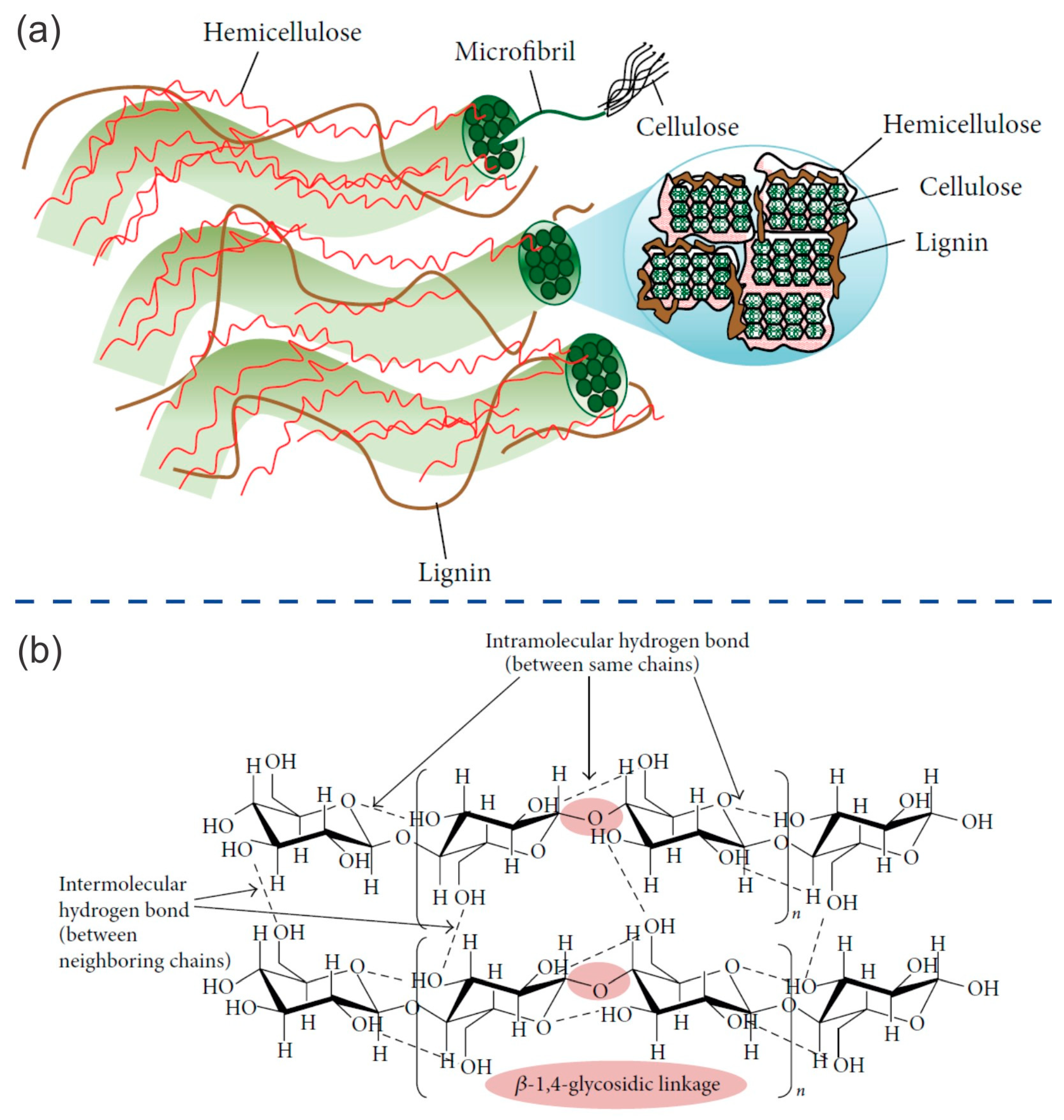

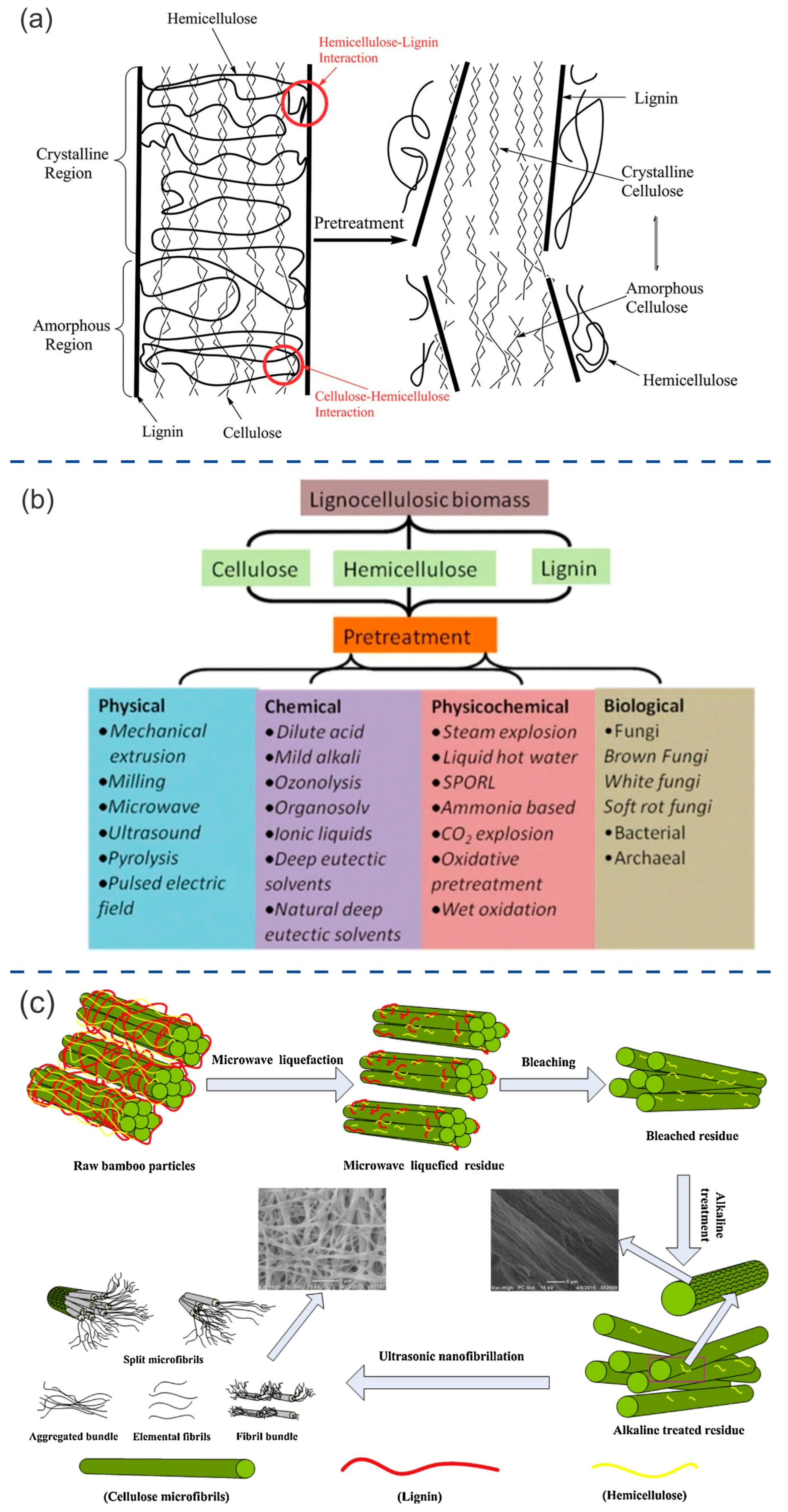
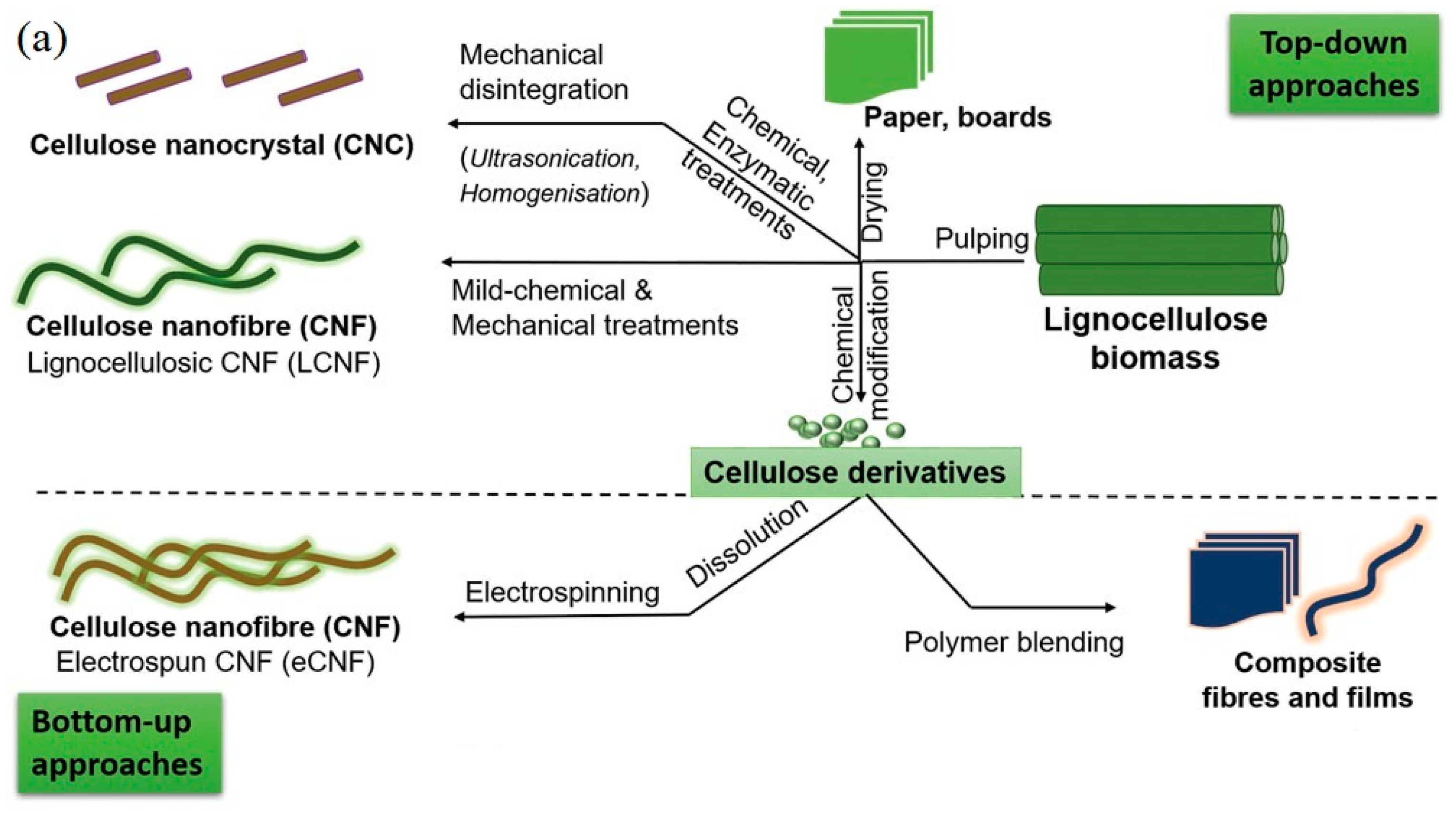
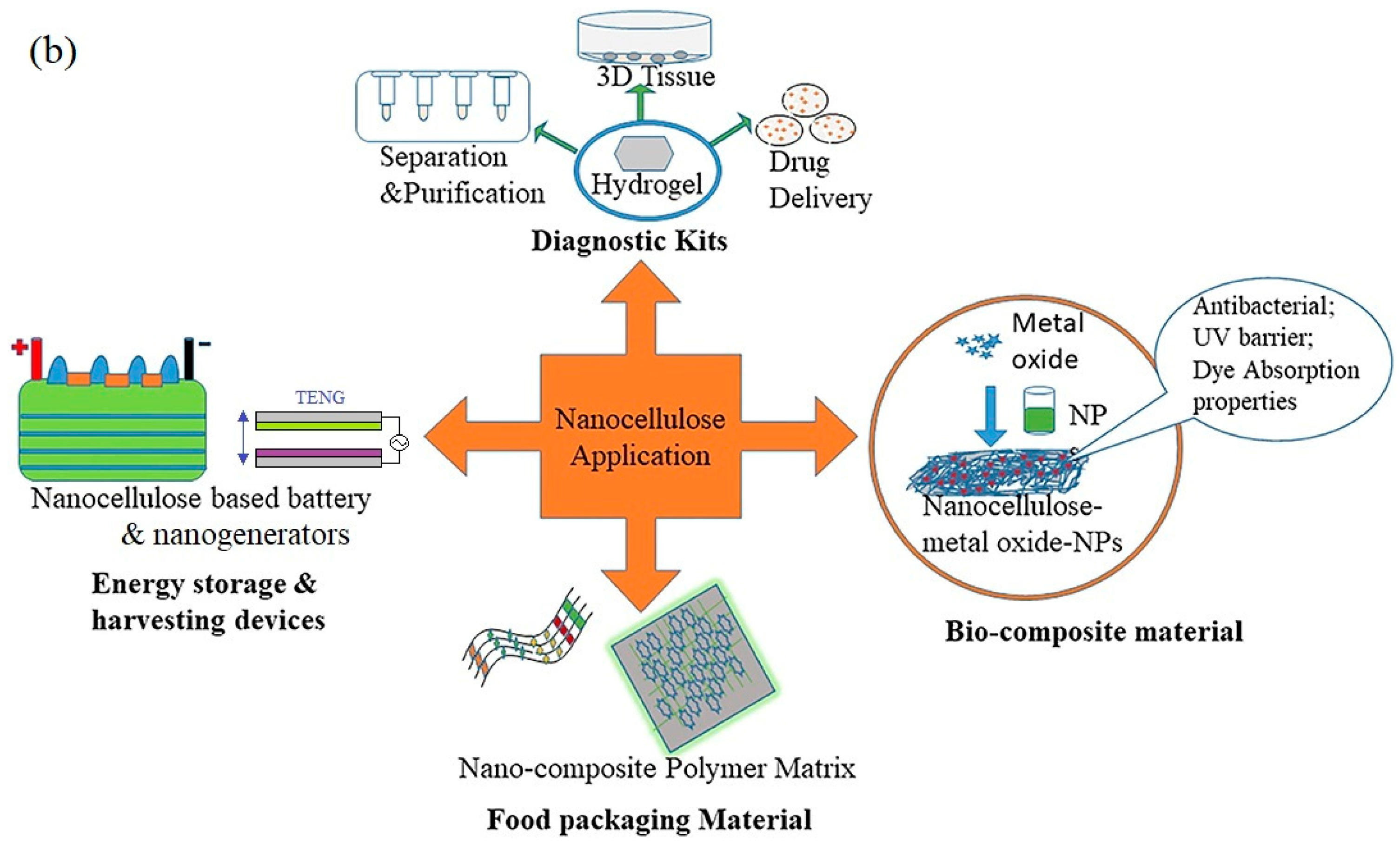
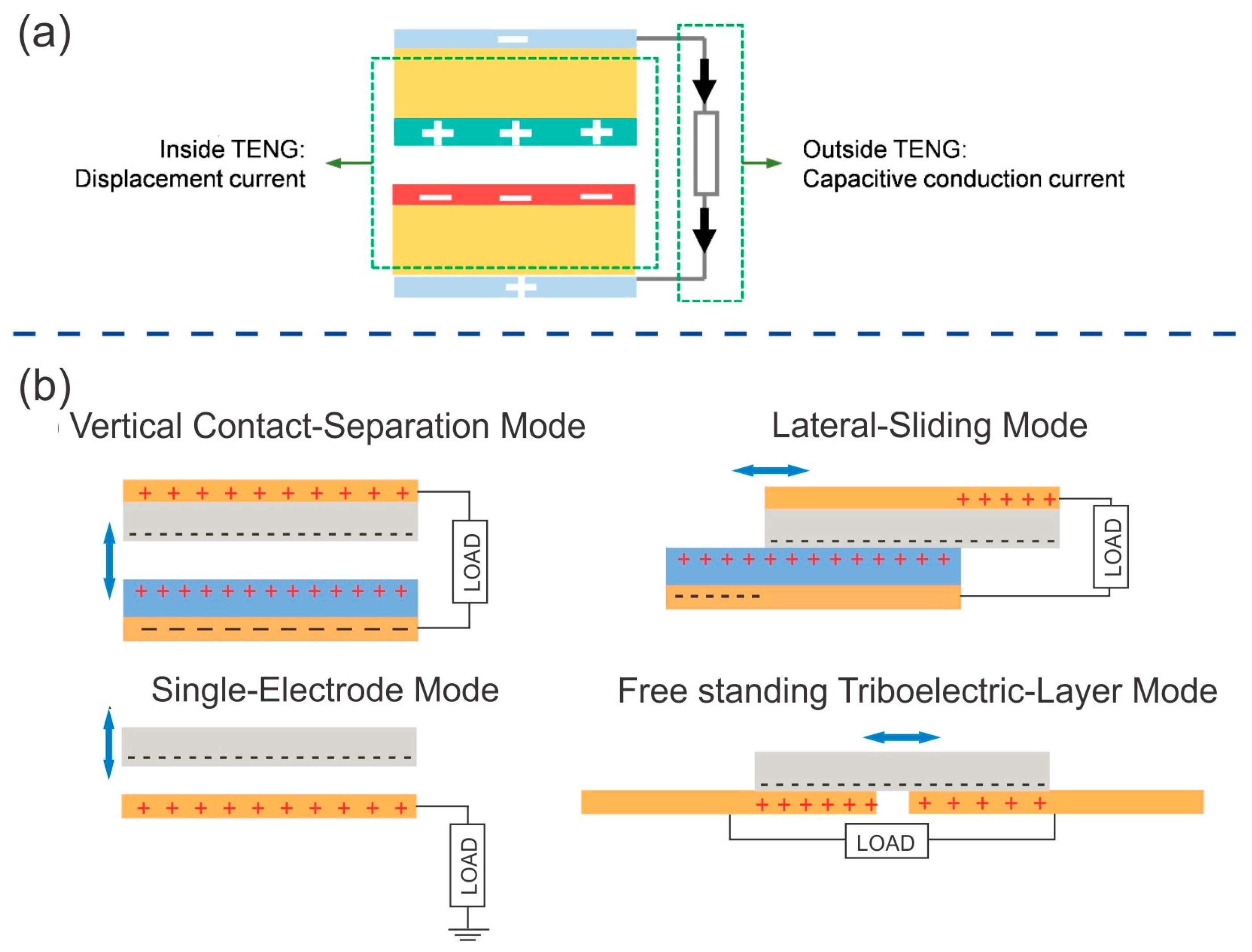
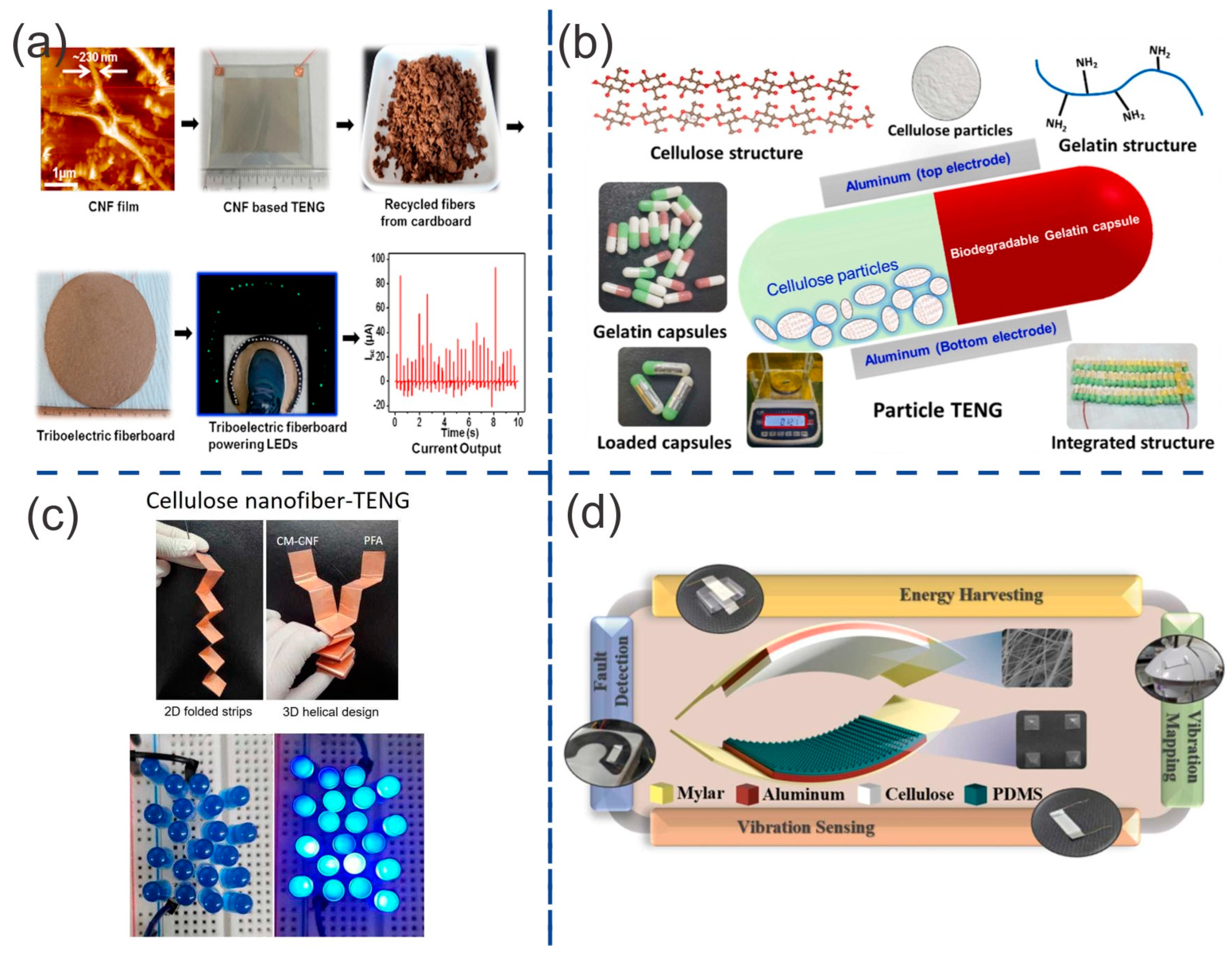
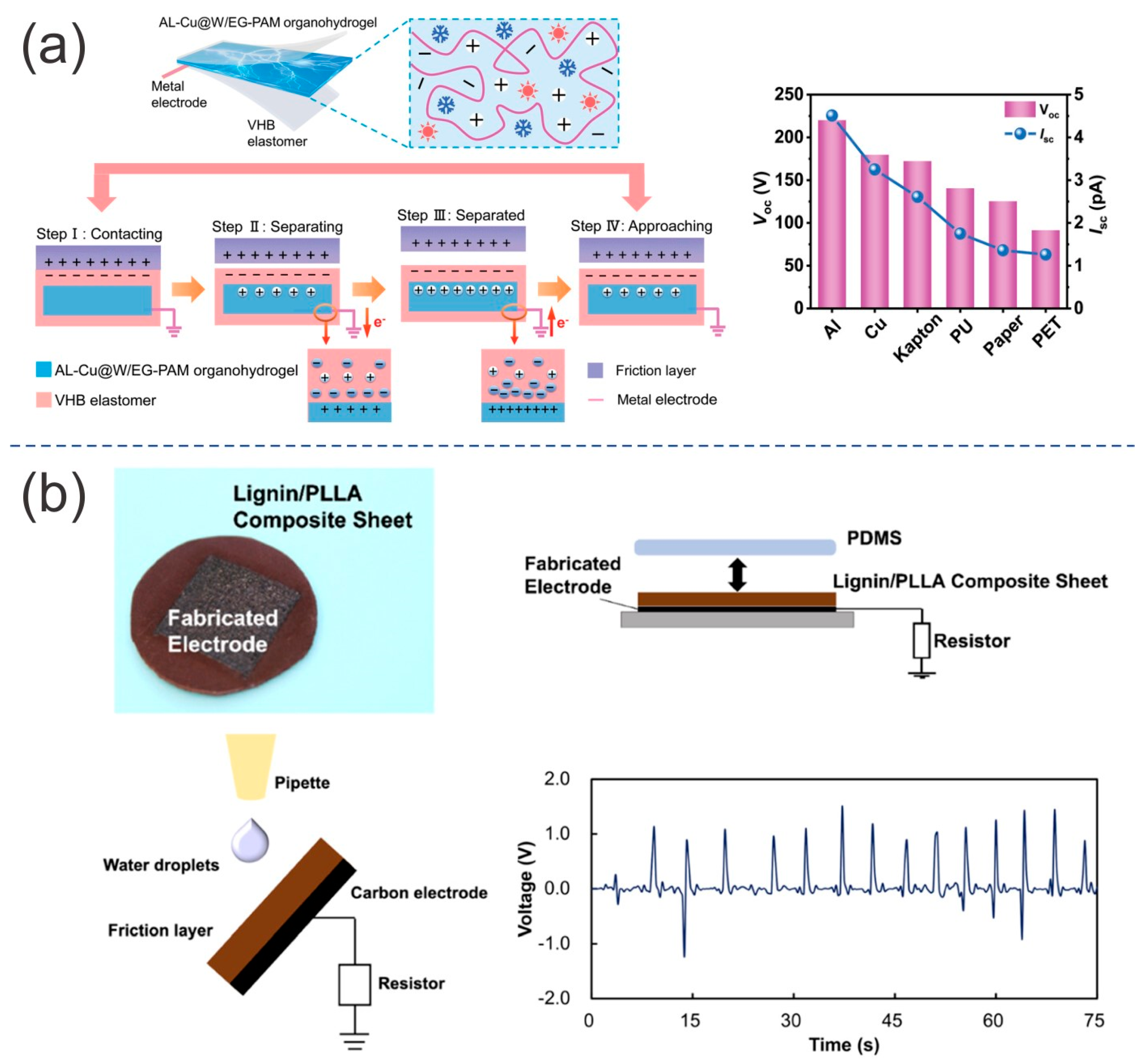
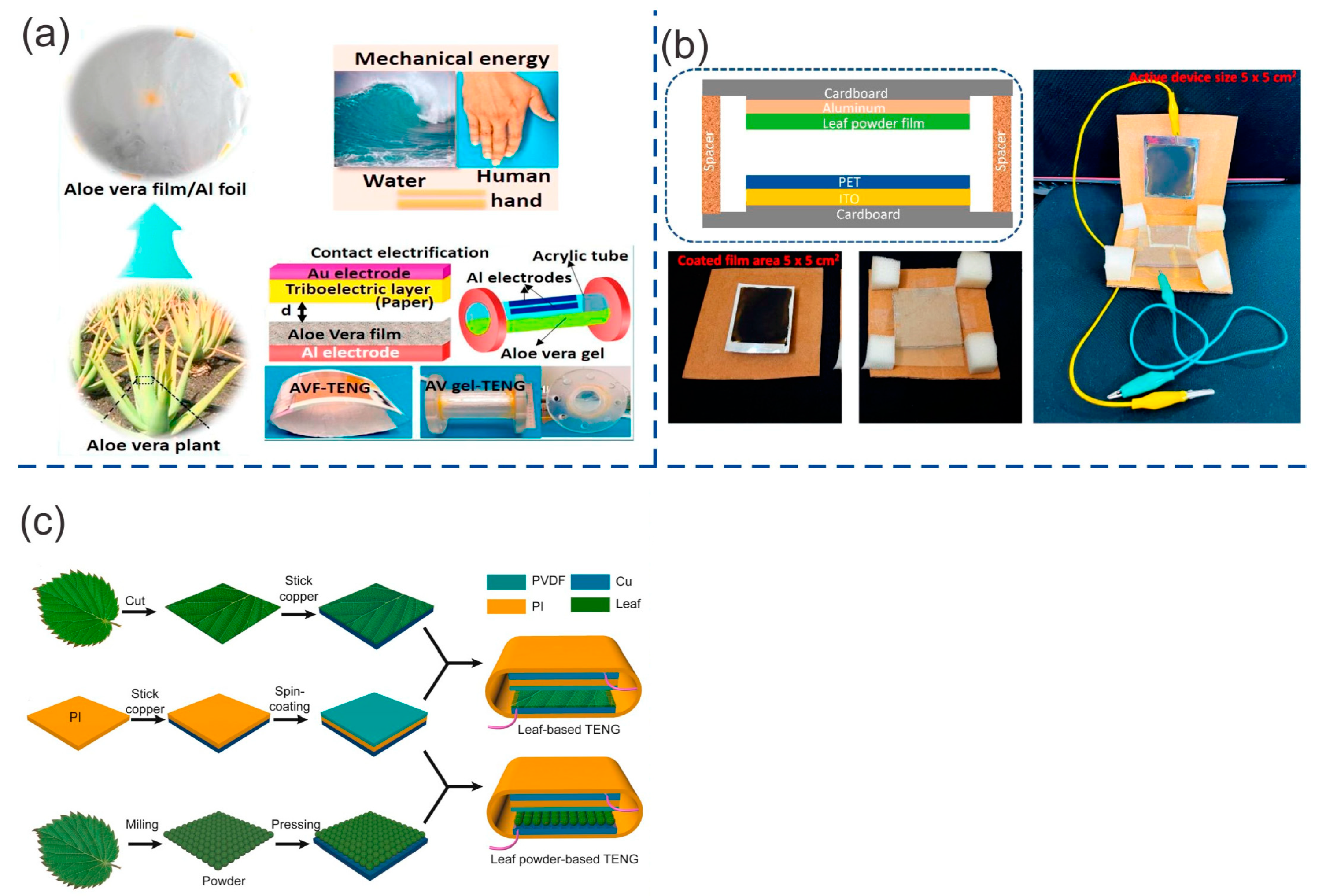
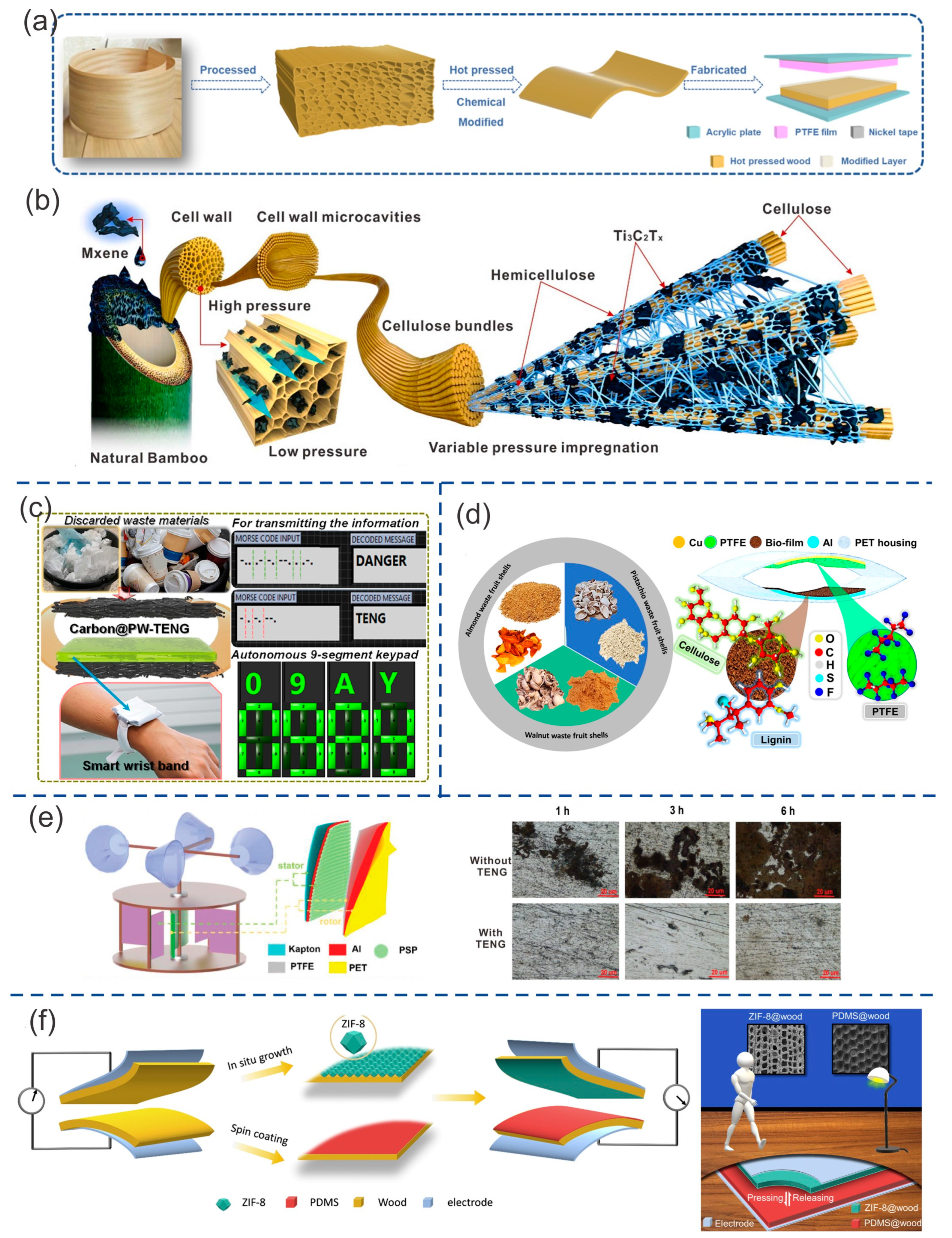
| Lignocellulosic Biomass | Triboelectric Materials | Dimensions and Conditions | Electrical Output | Applications | Refs. |
|---|---|---|---|---|---|
| Cellulose | CNF: FEP | 40 cm2 | 30 V, 0.035 mA, 0.56 mW (1 MΩ) | Industrial smart-floor | [71] |
| Cellulose: Gelatin | Pill size (length 20 mm and diameter 7 mm) | 15 V, 0.4 × 10−3 mA, 5.488 × 10−3 mW | Self-powering human motion-sensing | [72] | |
| Alc-S5-CNF: PET | 2 × 2 cm2, 12 N, 20 Hz | 7.9 V, 0.051 mA, 101.3 mW/m2 | Self-powering flexible small electronics | [73] | |
| CNF/TMS/Si NPs: FEP | 5 gears, 3 TENG units | 125 V, 0.006 mA, 0.038 mW (5 × 107 Ω) | Harvest water wave energy | [74] | |
| PEO/CCP-4: PDMS | 3 × 3 cm2, 40 N, 3 Hz | 222.1 V, 0.0043 mA, 217.3 mW/m2 (60 MΩ) | Human health detection device | [75] | |
| CM-CNF210/PFA | 100 cm2, 10 N, 2 Hz | 125 V, 0.012 mA, 2.07 mW (10 MΩ) | [76] | ||
| NR-CF@Ag_3: PTFE | 4 × 4 cm2, 5 N, 5 Hz | 128 V, 0.0124 mA, 3650 mW/m2 (0.7 MΩ) | [77] | ||
| CE NF: PDMS | 2 × 1 cm2, 3 N, 4 Hz | 400 V, 3 mA/m2, 900 mW/m2 (108 Ω) | Self-powered vibration analysis system | [78] | |
| Lignin | 0.5 M NaOH 6% glycerol 1:9 lignin-starch: Kapton | 6.5 × 6.5 cm2, 2.08 N, 0.5 Hz | 3.5 V/cm2, 23 nA/cm2, 1.735 mW/m2 | [79] | |
| Lignin NF: PI | 21.5 N, 10 Hz | 4.5 V | [80] | ||
| Alkali Lignin—Cu@W/EG-PAM: Al | 2 × 3 cm2, 3 Hz | 220 V, 4.5 pA | Monitoring finger and wrist-bending device | [81] | |
| Lignin/PLLA film: PDMS | 13 × 13 mm2, 10 N, 1 Hz | 15 V, 1.98 mW/m2 (200 MΩ) | Environmental harvesting devices | [82] | |
| Other lignocellulosic materials | Aloe Vera (AV) film: PDMS | 2.7 cm2, 2 m/s2 | 32 V, 0.11 µA, 1.9 mW/m2 (100 MΩ) | [83] | |
| AV gel: PDMS | 2.7 cm2 | 12.72 V, 113.23 nA | [83] | ||
| Half-cell Leek leaf skins | 182 V, 0.83 mA/m2, 35,100 mW/m2 | [84] | |||
| Leaves powder: PET | 5 × 5 cm2 | 3.86 V, 0.0037 mA, 1.894 mW/m2 (20 MΩ) | [85] | ||
| leaf powder/PLL: PVDF | 4 × 4 cm2, 5 Hz | 1000 V, 0.06 mA, 17.9 mW (11 MΩ) | Self-powered wind sensor | [86] | |
| Aloe Vera (AV) film: PDMS | 2.7 cm2, 2 m/s2 | 32 V, 0.11 µA, 1.9 mW/m2 (100 MΩ) | [83] | ||
| Non-refined lignocellulosic materials | Lignin/Cellulose/Citric Acid: PTFE | 2 × 2 cm2, 3.5 kPa, 1 Hz | 31 V, 0.0002 mA, 10 mW/m2 (80 MΩ) | Smart ward and medical monitoring system | [87] |
| paper cardboards | 8 × 8 cm2 | 30 V, 0.090 mA | Smart floor system | [71] | |
| Black walnut with surface modification | 3 × 3 cm2 | 335 V, 0.009 mA, 3800 mW/m2 | Self-powered real motion monitoring device for smart homes | [88] | |
| Cellulose/Ti3C2Tx with 8 h of delignification time | 60 V, 0.010 mA, 250 mW/m2 (7 × 105 Ω) | Self-powered humidity sensor | [89] | ||
| Paper wipes (PW)/15.13 wt% C NPs: PTFE from waste plastic coffee cups | 30 × 30 mm2, 30 N, 1 Hz | 80 V, 0.0015 mA, 0.58 mW (100 MΩ) | Smart wristband and self-powered 9-segment keyboard | [90] | |
| Pistachio waste fruit shell: PTFE | 4.5 × 4.5 cm2, 75 N, 10 Hz | 700 V, 95 mA, 4161.4 mW/m2 (3 MΩ) | Self-powered humidity sensor | [91] | |
| 1000 mesh peanut shell powder (PSP) film: PTFE | 2 Hz | 225 V, 0.035 mA 365 mW/m2 (8 MΩ) | Self-powered wind sensor and metal surface anti-corrosion system | [92] | |
| F-Wood: C-Wood | 2 × 2 cm2, 8.2 N, 3 Hz | 90.1 V, 0.458 μA, 0.545 mW (47 MΩ) | [93] | ||
| 20-ZIF-8@spruce(R):PDMS@spruce(R) | 2 × 3.5 cm2, 50 N | 24.3 V, 0.32 µA | Smart home devices | [68] | |
| Natural balsa wood film: PTFE | 3 × 3 cm2, 20 N, 1 Hz | 81 V, 1.8 µA, 0.051 mW (40 MΩ) | Smart ping-pong table | [94] | |
| Cotton fiber-based film: PDMS | 3 × 3 cm2, 2 Hz | 101.2 V, 2.65 μA, 205.6 mW/m2 (50 MΩ) | Self-powered wearable sensor | [95] | |
| COOH-SURMOF@Scindapsus: PDMS NH2-SURMOF: PDMS | 24 V, 2.8 µA | Self-powered wind sensor | [96] | ||
| Other biomaterial-based TENGs | Gelatin/PLA | 4 × 4 cm2 | 5000 mW/m2 | - | [97] |
| Chitosan/frustule silica | 3 × 4 cm2 | 15.7 mW/m2 | Skin-attachable motion sensor | [98] | |
| Alginate/polyethylene terephthalate | 4 × 1 cm2 | 1.33 mW/m2 | Pressure sensor | [99] | |
| Natural rubber/polytetrafluoroethylene | 4 × 4 cm2 | 237 mW/m2 | Power source to operate portable electronics | [100] | |
| Polylactic acid/graphene | 2 × 2 cm2 | 5400 mW/m2 | Biotechnology, optics, and catalyst fields | [101] |
Disclaimer/Publisher’s Note: The statements, opinions and data contained in all publications are solely those of the individual author(s) and contributor(s) and not of MDPI and/or the editor(s). MDPI and/or the editor(s) disclaim responsibility for any injury to people or property resulting from any ideas, methods, instructions or products referred to in the content. |
© 2023 by the authors. Licensee MDPI, Basel, Switzerland. This article is an open access article distributed under the terms and conditions of the Creative Commons Attribution (CC BY) license (https://creativecommons.org/licenses/by/4.0/).
Share and Cite
Troncoso, O.P.; Corman-Hijar, J.I.; Torres, F.G. Lignocellulosic Biomass for the Fabrication of Triboelectric Nano-Generators (TENGs)—A Review. Int. J. Mol. Sci. 2023, 24, 15784. https://doi.org/10.3390/ijms242115784
Troncoso OP, Corman-Hijar JI, Torres FG. Lignocellulosic Biomass for the Fabrication of Triboelectric Nano-Generators (TENGs)—A Review. International Journal of Molecular Sciences. 2023; 24(21):15784. https://doi.org/10.3390/ijms242115784
Chicago/Turabian StyleTroncoso, Omar P., Jim I. Corman-Hijar, and Fernando G. Torres. 2023. "Lignocellulosic Biomass for the Fabrication of Triboelectric Nano-Generators (TENGs)—A Review" International Journal of Molecular Sciences 24, no. 21: 15784. https://doi.org/10.3390/ijms242115784
APA StyleTroncoso, O. P., Corman-Hijar, J. I., & Torres, F. G. (2023). Lignocellulosic Biomass for the Fabrication of Triboelectric Nano-Generators (TENGs)—A Review. International Journal of Molecular Sciences, 24(21), 15784. https://doi.org/10.3390/ijms242115784










